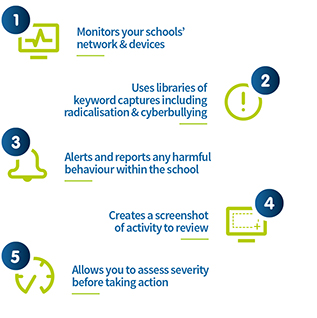
As of the 5th September, solely using web filters to protect students from harmful content is no longer sufficient and schools are expected to be more proactive in monitoring online activity.
An increased emphasis on online safety means that schools are now expected to implement an appropriate and effective monitoring system, which adheres to the Prevent duty and also supports the latest guidelines in Keeping Children Safe in Education (KCSiE). The use of technology is now a significant component of many safeguarding issues, including radicalisation, child exploitation and sexual predation. The guidance calls for all schools to employ effective online safeguarding mechanisms to empower children and protect them from online dangers. Compliance will now be inspected as part of Ofsted’s Common Inspection Framework.Proactive technology monitoring solutions
To address this safeguarding responsibility we recommend that schools implement and maximise proactive technology monitoring solutions.
The technology available is developing rapidly and allows schools to monitor activity through keywords and other indicators originating from devices across the premises. Schools can benefit from ‘push notification' alerts direct to a dedicated safeguarding officer, which can prove particularly effective in drawing attention to concerning behaviours, communications or access. There are existing libraries of specific keywords which address a range of issues, and staff have the ability to add more words or slang to be monitored by the software.

How proactive technology monitoring solutions work
Which harmful content is monitored?
Here are the definitions of the types of content monitored and reported back to your school:- Illegal - Content that is illegal (e.g. Child abuse images and terrorist content)
- Child Sexual Exploitation - Encourages the child into a coercive/manipulative sexual relationship. This may include encouragement to meet
- Bullying - Involves the repeated use of force, threat or coercion to abuse, or aggressively dominate others
- Extremism - Promotes terrorism and terrorist ideologies, violence or intolerance (fulfilling your Prevent duty)
- Drugs/Substance abuse - Displays or promotes the illegal use of drugs or substances
- Violence - Displays or promotes the use of physical force intended to hurt or kill
- Suicide - Suggests the user is considering suicide
- Pornography - Displays sexual acts or explicit images
- Discrimination - Promotes the unjust or prejudicial treatment of people on the grounds of race, religion, age, sex, disability or gender identity.
If you would like to discuss how SBS can implement proactive technology monitoring solutions within your school, please email admin@schoolbusinessservices.co.uk or call 0345 222 1551 • Option 7.
More Information
Filtering and monitoring systems are just the tools available in helping to safeguard children when online and schools have an obligation to “consider how children may be taught about safeguarding, including online, through teaching and learning opportunities, as part of providing a broad and balanced curriculum” – excerpt from DfE publication: Keeping Children Safe in Education (KCSiE) We have found some useful resources to download template policies: http://swgfl.org.uk/products-services/esafety/resources/online-safety-policy-templates
Get sector Insights delivered straight to your inbox.
Subscribe to to the SBS Blog and never miss an update.

